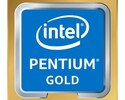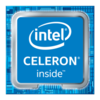Intel Pentium Gold 6500Y vs Intel Celeron N5095A
Intel Pentium Gold 6500Y

Der Intel Pentium Gold 6500Y ist ein sparsamer Dual-Core-SoC für Tablets und kleine Notebooks basierend auf die alte Amber-Lake-Architektur. Technisch ist er fast identisch mit dem alten Intel Core m3-8100Y. Laut Intel unterscheiden sich die beiden Chips nur durch die leicht unterschiedlichen TDP-up und TDP-down Optionen (3,5 - 7 Watt beim 6500Y versus 4,5 - 8 W beim m3-8100Y) und das die integrierte GPU eine Ausführungseinheit weniger hat (23 der 24 EUs).
Die CPU integriert 2 Prozessorkerne, die mit 1,1 bis 3,4 GHz takten. Dank Hyper-Threading kann der Prozessor vier Threads gleichzeitig bearbeiten. Weiterhin integriert der Chip eine Intel UHD Graphics 615 Grafikkarte, einen Dual-Channel-Speichercontroller (DDR3L/LPDDR3) sowie VP9- und H.265-Videode- und -encoder. Die Fertigung erfolgt weiterhin in einem 14-Nanometer-Prozess mit FinFET-Transistoren.
Architektur
Im Vergleich mit Skylake und Kaby Lake hat Intel die zugrundeliegende Mikroarchitektur praktisch unverändert übernommen, sodass sich keine Unterschiede in der Pro-MHz-Leistung ergeben. Der gereifte 14-Nanometer-Prozess (nicht 14nm+) erlaubt jedoch deutlich höhere Frequenzen als bisher.
Performance
Durch den sehr niedrigen TDP bietet die Y-Serie nicht das Leistungsniveau der anderen Core-i-Prozessoren. Der Core m3-8100Y zeigte in unseren Test eine eher schwache Leistung (siehe Seite des m3-8100Y), die nur für anspruchslose Aufgaben ausreicht.
Grafikeinheit
Die integrierte Intel UHD Graphics 615 Grafikkarte wurde im Vergleich zur HD Graphics 615 nicht verändert und bietet weiterhin 24 Ausführungseinheiten (EUs) und eine Taktrate von 300 (Basis, garantiert) bis 950 MHz (maximaler Boost). Beim Pentium Gold 6500Y sind aber laut Intel Ark nur 23 der 24 EUs aktiviert. Die Performance hängt stark von der eingestellten TDP sowie dem verwendeten Arbeitsspeicher ab. Mehr Informationen hierzu finden Sie auf der UHD 615 GPU-Seite.
Anders als Skylake kann Kaby Lake und Amber Lake nun auch H.265/HEVC im Main10-Profil mit 10 Bit Farbtiefe sowie Googles VP9-Codec in Hardware decodieren.
Leistungsaufnahme
Die Fertigung erfolgt im gereiften 14-Nanometer-Prozess (14nm+) mit FinFET-Transistoren (kein 14nm++), wodurch die Energieeffizienz nochmals gestiegen ist. Die TDP wird mit 5 Watt spezifiziert (Kaby-Lake-Y noch 4,5 Watt) und kann je nach Einsatzzweck nach oben (7 Watt) oder unten (3,5 Watt) variiert werden.
Intel Celeron N5095A
► remove from comparison
The Celeron N5095A is an inexpensive quad-core SoC of the Jasper Lake product family designed for use in affordable SFF desktops and laptops. It features four Tremont CPU cores running at 2 GHz that Boost to up to 2.9 GHz with no thread-doubling Hyper-Threading technology in sight. A pretty basic iGPU is present as well.
The only difference between the N5095A and the N5095 is that the former comes with support for more proprietary Intel technologies such as the Smart Sound DSP, Wake on Voice and HD Audio.
Architecture and Features
Tremont brings many improvements over Goldmont Plus, the architecture that we know from the N5030 and myriads of other N-class CPUs. An up to 30% boost in single-thread performance is to be expected thanks to smarter prefetchers, branch prediction improvements and other refinements, according to Intel. These new chips are physically larger than their immediate predecessors as a result. Either way, this is still a "small" core rather than a "big" one according to ChipsAndCheese.
The Celeron has 1.5 MB of L2 and 4 MB of L3 cache and is compatible with DDR4-2933 and LPDDR4x-2933 memory or slower. Support for Intel CNVi Wi-Fi 6 modules is baked into the chip, as are 8 PCIe 3.0 lanes for NVMe SSD speeds up to 3.9 GB/s. USB 4 or Thunderbolt aren't supported however.
Please also note that the Celeron gets soldered to the motherboard (BGA1338 socket interface) for good and is thus not user-replaceable.
Performance
While we haven't tested a single system featuring the N5095A as of Sep 2024, we have done several reviews of computers/laptops powered by the N5095. CPU performance should be pretty much identical between the two. Therefore, we fully expect the chip to be about as fast as the Core i3-10110U, Core i3-1005G1, Celeron N5105 and also the Ryzen 3 3200U in multi-threaded workloads. Which is just enough for the most basic of tasks in late 2024.
Performance will get a significant hit if the power target is set to 10 W or 6 W instead of the Intel-recommended 15 W value.
Graphics
The DirectX 12.1-capable 16 EU UHD Graphics runs at up to 750 MHz and is in many respects similar to what Ice Lake CPUs come equipped with. This graphics adapter is capable of driving up to 3 SUHD displays simultaneously; HEVC, AVC, VP9, MPEG-2 and other popular video codecs can all be hardware-decoded. AV1 and VVC can't.
As far as gaming is concerned, it is reasonable to expect playable framerates in really old games (like Dota 2 Reborn) provided one sticks to lower resolutions such as HD 720p.
Power consumption
While most N-class chips have a 6 W long-term power target, the Celeron N5095A has a 15 W TDP to mimic much faster U-class Core processors. This isn't a great CPU for passively cooled designs.
The N5095A is built with the same 10 nm Intel process as Ice Lake-U processors for pretty unimpressive power efficiency, as of late 2024.
| Model | Intel Pentium Gold 6500Y | Intel Celeron N5095A | ||||||||||||||||||||||||||||||||||||||||||||||||||||||||||||||||||||
| Codename | Amber Lake-Y | Jasper Lake | ||||||||||||||||||||||||||||||||||||||||||||||||||||||||||||||||||||
| Series | Intel Amber Lake | Intel Jasper Lake | ||||||||||||||||||||||||||||||||||||||||||||||||||||||||||||||||||||
| Serie: Jasper Lake Jasper Lake |
|
| ||||||||||||||||||||||||||||||||||||||||||||||||||||||||||||||||||||
| Clock | 1100 - 3400 MHz | 2000 - 2900 MHz | ||||||||||||||||||||||||||||||||||||||||||||||||||||||||||||||||||||
| L1 Cache | 128 KB | |||||||||||||||||||||||||||||||||||||||||||||||||||||||||||||||||||||
| L2 Cache | 512 KB | 1.5 MB | ||||||||||||||||||||||||||||||||||||||||||||||||||||||||||||||||||||
| L3 Cache | 4 MB | 4 MB | ||||||||||||||||||||||||||||||||||||||||||||||||||||||||||||||||||||
| Cores / Threads | 2 / 4 | 4 / 4 4 x 2.9 GHz Intel Tremont | ||||||||||||||||||||||||||||||||||||||||||||||||||||||||||||||||||||
| TDP | 5 Watt | 15 Watt | ||||||||||||||||||||||||||||||||||||||||||||||||||||||||||||||||||||
| Technology | 14 nm | 10 nm | ||||||||||||||||||||||||||||||||||||||||||||||||||||||||||||||||||||
| max. Temp. | 100 °C | |||||||||||||||||||||||||||||||||||||||||||||||||||||||||||||||||||||
| Features | DDR3L-1600/LPDDR3-1866 RAM, PCIe 3, 4 GT/s bus, MMX, SSE, SSE2, SSE3, SSSE3, SSE4.1, SSE4.2, AVX, AVX2, BMI2, ABM, FMA, ADX, VMX, SMEP, SMAP, MPX, EIST, TM1, TM2, Hyper-Threading, Turbo, SST, AES-NI, RDRAND, RDSEED, SGX | DDR4-2933/LPDDR4x-2933 RAM, PCIe 3, GNA, MMX, SSE, SSE2, SSE3, SSSE3, SSE4.1, SSE4.2, VMX, SMEP, SMAP, EIST, TM1, TM2, Turbo, SST, AES-NI, RDRAND, RDSEED, SHA | ||||||||||||||||||||||||||||||||||||||||||||||||||||||||||||||||||||
| iGPU | Intel UHD Graphics 615 (300 - 900 MHz) | Intel UHD Graphics (Jasper Lake 16 EU) (450 - 750 MHz) | ||||||||||||||||||||||||||||||||||||||||||||||||||||||||||||||||||||
| Architecture | x86 | x86 | ||||||||||||||||||||||||||||||||||||||||||||||||||||||||||||||||||||
| Announced | ||||||||||||||||||||||||||||||||||||||||||||||||||||||||||||||||||||||
| Manufacturer | ark.intel.com | ark.intel.com | ||||||||||||||||||||||||||||||||||||||||||||||||||||||||||||||||||||
| Socket | BGA1338 |
Benchmarks
Average Benchmarks Intel Pentium Gold 6500Y → 0% n=0
* Smaller numbers mean a higher performance
1 This benchmark is not used for the average calculation













